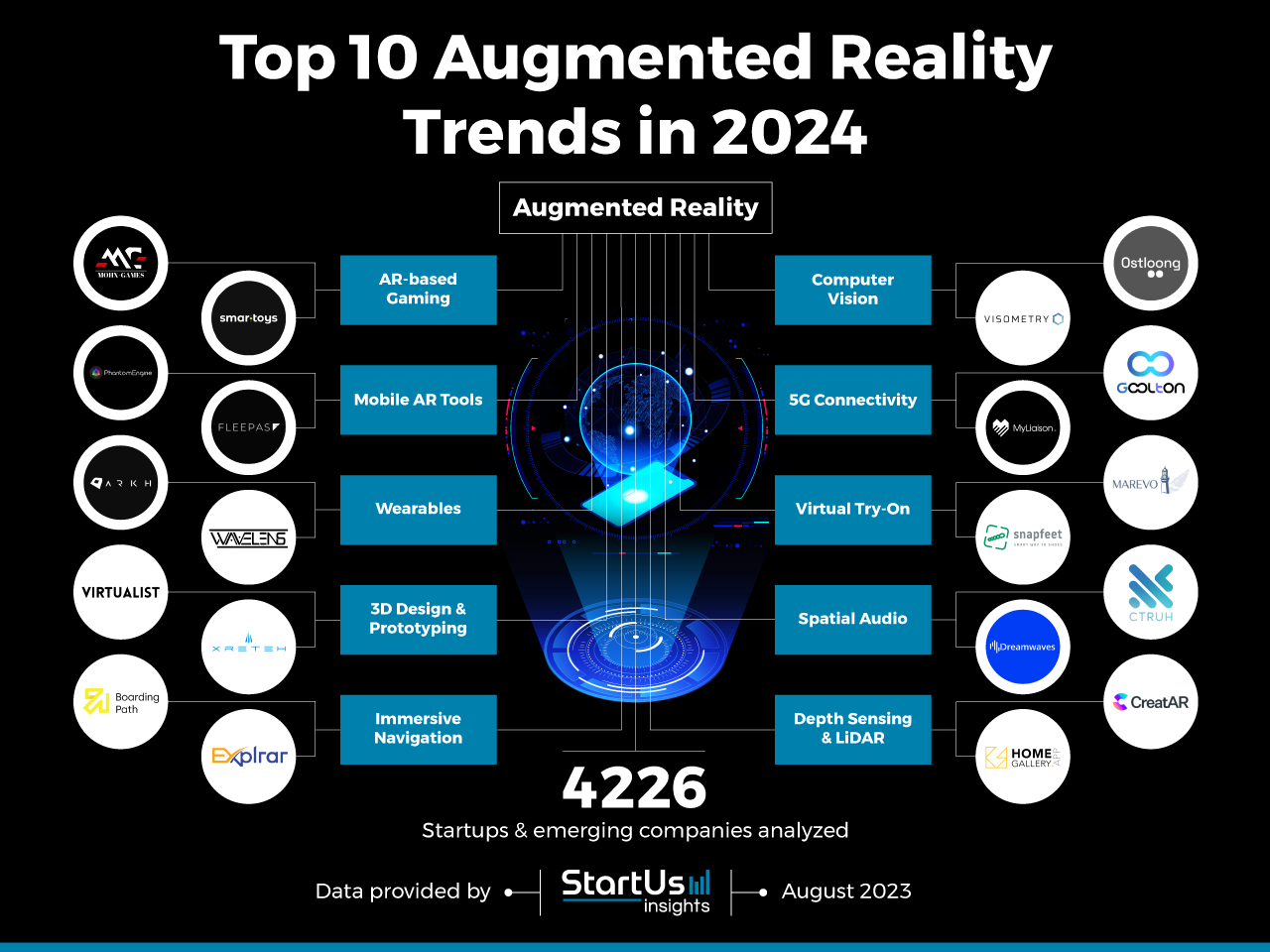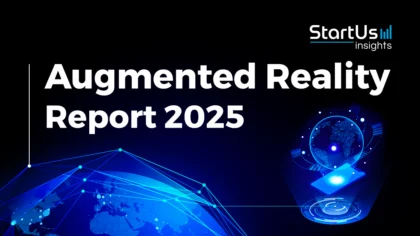Accelerate Productivity in 2025
Reignite Growth Despite the Global Slowdown
From enhancing immersive gaming experiences to simplifying educational concepts, AR’s use cases penetrate almost every industry today. AR combines computer-generated elements with the real environment to enhance user perception and interaction. This research provides you with the top 10 augmented reality trends in 2024, ranging from shared AR gaming and mobile AR tools to spatial audio and LiDAR. Newer technologies like 5G and wearables further enhance AR experiences. Read more to explore each trend and find out how your business can leverage it.
Innovation Map outlines the Top 10 AR Trends & 20 Promising Startups
For this in-depth research on the Top Augmented Reality Trends & Startups, we analyzed a sample of 4226 global startups & scaleups. This data-driven research provides innovation intelligence that helps you improve strategic decision-making by giving you an overview of emerging technologies in the AR industry. In the Augmented Reality Innovation Map, you get a comprehensive overview of the innovation trends & startups that impact your company.
Top 10 Latest Trends in Augmented Reality (2024)
- AR-based Gaming
- Mobile AR Tools
- Wearables
- 3D Design & Prototyping
- Immersive Navigation
- Computer Vision
- 5G Connectivity
- Virtual Try-On
- Spatial Audio
- Depth Sensing & LiDAR
These insights are derived by working with our Big Data & Artificial Intelligence-powered StartUs Insights Discovery Platform, covering 3 790 000+ startups & scaleups globally. As the world’s largest resource for data on emerging companies, the SaaS platform enables you to identify relevant technologies and industry trends quickly & exhaustively.
Tree Map reveals the Impact of the Top 10 Augmented Reality Innovations & Trends
Based on the AR Innovation Map, the Tree Map below illustrates the impact of the Top Augmented Reality Trends in 2024. Novel AR devices and software stacks reduce latency, increase overlay quality, and more. The most prevalent trend is AR gaming as extended reality enables (XR) interactive gameplay experiences that captivate gamers. Mobile AR, virtual try-on, and LiDAR collectively empower businesses to create user-friendly tools that enable businesses to craft engaging content for marketing.
While 3D design and prototyping allow businesses to test product designs, 5G connectivity enables them to reduce latency in AR content delivery with high-speed data transmission. Further, immersive navigation enables travelers to tour more intuitively with contextual information and computer vision allows these systems to better understand the surroundings and enable object recognition. Finally, AR-powered wearables deliver hands-free experiences and spatial audio enhances immersion by linking audio to the location of virtual objects.
Global Startup Heat Map covers 4226 AR Startups & Scaleups
The Global Startup Heat Map below highlights the global distribution of the 4226 exemplary startups & scaleups that we analyzed for this research. Created through the StartUs Insights Discovery Platform, the Heat Map reveals high startup activity in the US and UK, followed by India. Below, you get to meet 20 out of these 4226 promising startups & scaleups as well as the solutions they develop. These AR startups are hand-picked based on criteria such as founding year, location, funding raised, & more. Depending on your specific needs, your top picks might look entirely different.
Top 10 Augmented Reality Trends and Innovations (2024)
1. AR-based Gaming
As gamers seek more realistic and engaging AR gameplay, developers create better AR devices with improved tracking, display capabilities, and user interfaces. Game developers integrate AR elements into their games for players to interact with virtual objects and characters in the real world. This expands the AR gaming genre and also leads to the development of AR frameworks and tools to use in various non-gaming applications.
Gaming companies also utilize AR to create location-based games. They allow players to engage with virtual content tied to specific physical locations. This includes solving puzzles or completing challenges at real-world landmarks or businesses. Some startups, instead of building entire AR games, incorporate AR elements within traditional games. This approach encourages players to use AR to unlock bonuses or discover easter eggs within the game.
Mohx-games advances Multiplayer AR-Game Development
Mohx-games is a US-based startup that develops XR-EAS, a platform that allows companies to develop AR and virtual reality (VR) multiplayer games. It enables gamers to share AR experiences with up to 8 other people. The platform is easy to use and requires no setup.
XR-EAS uses an ongoing correction system to ensure that gamers’ positions remain accurate over time, even if there are variations in hardware among the devices. It enables more immersive multiplayer AR experiences for all participants, enhancing player satisfaction in entertainment, gaming, or remote telepresence applications.
smar.toys integrates Toys with AR Gameplay
German startup smar.toys offers an attachment system and controller for integrating AR gameplay with existing toy guns and devices. The toy gun-compatible attachment system allows people to attach a phone and convert it into an AR gaming controller. The startup’s Bow Controller allows the user to attach their smartphone to the controller directly and play AR games, mitigating the need for a separate viewer and controller.
By incorporating long-range infrared emitters, the controller adds complexity and realism to the gaming experience. The foldable design of the controller makes it easier for gamers to transport and store the device when not in use. smar.toys’ controllers thus enable new AR gamers to access immersive experiences without expensive headsets and wearables.
2. Mobile AR Tools
Mobile AR tools leverage advances in smartphone cameras, sensors, and processing power to increase the performance of AR interactions. They enhance the accuracy of AR applications and enable more realistic and immersive experiences. Also, mobile AR contributes to the widespread adoption of AR technology as it increases the accessibility of AR apps.
Various AR development kits and platforms are available for mobile software developers to create AR apps without starting from scratch. These development kits offer tools for tracking, image recognition, 3D rendering, and more. They streamline the development process and benefit industries like healthcare, engineering, and aviation. Mobile AR enhances training and education by offering interactive, 3D visualizations and simulations.
Phantom Technology offers a Mobile AR Development Platform
UK-based startup Phantom Technology provides PhantomEngine, a mobile AR development platform to create context-aware AR applications for mobile devices. The platform utilizes a proprietary software development kit (SDK) that combines spatial mapping, AR pathfinding, and object recognition to create realistic environments. By constructing a 3D mesh of the user’s surroundings, the platform allows for the development of AR games with realistic physics-based mechanics.
By integrating this SDK with existing game engines, developers accelerate production pipelines and access to AR features that enhance the realism and engagement of mobile games. This also makes it an efficient solution for businesses to add AR functionality to their products or services while mitigating in-house software development.
Fleepas delivers Location-based Mobile AR Experiences
Fleepas is a Spanish startup that develops a mobile app to create location-based AR experiences. The app recognizes the users’ location and integrates an AR experience or game into that location. It then allows other users to play the content and maintain a score in that location after scanning it with their phone.
While users engage with AR activities, the app enables retailers and store owners to craft engaging customer experiences to drive sales and boost retention. Due to its gamified nature, AR experiences attract foot traffic and amplify revenue streams compared to regular advertising. They also cut down on overall advertising costs, helping small businesses.
3. Wearables
One of the key advantages of wearables, such as smart glasses and head-mounted displays (HMDs), is that they offer a hands-free experience. They enable users to access AR content and information seamlessly without needing to hold a separate device. Consequently, AR wearables enhance convenience and usability. They also allow wearers to interact with AR content more naturally.
In industries like manufacturing, engineering, and logistics, wearables with AR capabilities allow workers to visualize complex data and instructions directly in their field of view (FOV). This aids in training processes by providing real-time guidance and reducing the risk of errors.
ARKH offers a Wearable AR Controller
ARKH is a US-based startup that develops a wearable controller for AR experiences. The wearable controller sits between the index and middle fingers and connects to a mobile device via Bluetooth. As compared to handheld controllers, ARKH’s controller allows users to interact with AR objects more intuitively. It also enables precise input with its touch surface on the underside, custom haptic feedback system, and motion-tracking sensors.
The small form factor of the controller makes it highly portable and easy to carry around, making it helpful in industrial and professional environments. The controller’s precise input, motion tracking sensors, and SDK enable developers to create more engaging and user-friendly AR games and apps.
Wavelens makes AI-powered AR Glasses
German startup Wavelens creates AI-based augmented reality glasses. The glasses combine AI and LiDAR to enable a variety of use cases, including navigation, wireless interaction, text translation, and information access. This allows users to control various devices and systems through virtual buttons and gestures to add convenience and interactivity to daily tasks.
By instantly detecting and translating text in real-time, the glasses also facilitate communication and information exchange between people who speak different languages. Developers integrate live translation and immersive navigation into their applications, making them ideal for travel, communication, and educational apps, enhancing cross-language interactions.
4. 3D Design & Prototyping
AR Plays a crucial role in the development and enhancement of 3D design and prototyping across various industries. It enables developers to create realistic 3D models and simulations to drive decision-making. Prototypes allow developers to conduct user testing and gather feedback. Industries like architecture, interior design, and automotive use AR to visualize products and designs in real-world contexts.
This enables them to identify potential challenges or opportunities early in the development process and make necessary improvements. Consequently, AR-assisted design leads to a more refined product experience for end-users. 3D models also empower stakeholders to understand how a finished product will look and function, enabling better decision-making and reducing design errors.
Virtualist offers an AR-based Building Design Platform
Virtualist is an Irish startup that develops an AR-based building design platform that aids businesses visualize projects before they are built. It allows architects to import computer-aided design (CAD) files and textures into a virtual environment to view and manipulate in real-time. The platform also works on mobile devices, enabling builders and designers to project the designs using AR and review the projects on the go.
By visualizing projects before they are built, businesses identify and address potential problems early on. This leads to fewer design revisions during construction, which saves time and money. It also allows designers to prototype their 3D scenes in real places and remotely collaborate with clients more effectively.
XRETEH develops an Immersive Design App
Romanian startup XRETEH provides an AR-based design platform that allows architects, AR designers, and developers to create, share, and monetize their work. The app overlays digital designs onto physical spaces in real-time. This allows designers to get a more accurate sense of how the project will look post-completion.
The app also makes it easier for developers to experiment with different design ideas and get feedback from colleagues and clients in real time. This enables them to convey designs to potential customers more immersively, leading to higher-quality projects and increased customer satisfaction.
5. Immersive Navigation
AR-based navigation enhances the traveler experience by overlaying digital information onto the real-world environment. It allows commuters to receive real-time directions, points of interest, and other contextual information seamlessly, making navigation more intuitive and engaging. AR-powered navigation also aids them in identifying landmarks, obstacles, and important locations in real time.
Advanced AR navigation systems leverage real-time data to provide up-to-date information about routes and traffic conditions. This requires robust data integration and communication with various data sources, pushing the development of AR and its integration with other systems. AR navigation also finds use for wayfinding inside large buildings like airports, shopping malls, or hospitals. This helps travelers and tourists find specific locations or navigate complex interiors with ease.
Boarding Path provides AR-based Navigation in Airports
Boarding Path is a Canadian startup that offers an eponymous travel concierge app that aids travelers navigate airports and other travel destinations. It uses smartphone cameras and AR overlays to guide the traveler through airport terminals, making it easier to find gates, lounges, and other amenities.
The app also features voice control for users to interact with the navigation using voice commands. It further allows travelers to translate signboards to enhance the generally cumbersome airport navigation experience for travelers regardless of their origin and language.
Explrar delivers AR-powered Navigation for Travelers
Singaporean startup Explrar makes a travel companion app that combines AI and AR to simplify and enhance the travel experience. It also has a companion smartphone app that utilizes cameras to overlay practical real-time directions. The app allows travelers to point the camera at a landmark and discover interesting information.
The app also enables travelers to translate foreign text instantly, making navigating in a new city effortlessly. Explrar’s AR-based navigation experience enhances the traveling experience while saving time.

6. Computer Vision
Companies combine computer vision systems and AR to understand and interpret the real-world environment. This enables AR systems to detect and track objects, recognize scenes, and provide a seamless integration of virtual content with the real world. Computer vision also allows AR systems to recognize and understand different surfaces, textures, and landmarks. This information ensures that it places virtual objects appropriately in the real world, providing a more immersive experience.
Scene recognition finds use in architectural visualization, city planning, and more. Developers also integrate computer vision with AR applications to recognize gestures. This enables users to interact with virtual objects in a more natural and intuitive way. For example, users manipulate virtual objects through hand gestures or control AR interfaces using simple movements in AR gaming.
Ostloong Innovations facilitates AR-based Translation
Ostloong Innovations is a Swiss startup that develops Lyra, a pair of AR glasses. It utilizes AR and computer vision to provide users with real-time translation and navigation. The glasses use optical waveguide lenses to provide information near the eyes of the user. Using its inbuilt AI assistant, Lyra understands and overlays real-time subtitles to conversations, enabling users to travel without language barriers.
Lyra also facilitates multilingual note-taking and uses mobile data connectivity for calls and messages. Oostloong Innovations’ glasses finds useful in accessing instructions, translating documents, and navigating unfamiliar environments.
Visometry delivers AR-based Visual Inspections
German startup Visometry offers Twyn, an AR and computer vision-based mobile platform for visual quality inspection in the manufacturing industry. After uploading 3D models of the product, the platform allows manufacturers to superimpose the model onto the final product and check for size irregularities and quality issues. It also allows them to digitally verify whether add-on parts are complete or whether engineering design drafts fit into an assembly.
Twyn thus enables businesses to find errors before successive production stages start, avoiding costly delays, downtimes, and rework. It allows for vision-assisted automated analysis to point out and warn manufacturers of potential issues in manufacturing processes. Visometry’s computer vision technology enables markerless 3D model alignment to reduce inspection set-up and tooling time, reducing manufacturing costs.
7. 5G Connectivity
Compared to earlier iterations of AR, 5G-powered AR systems address the need for high data transfer speeds and low latency required to ensure seamless and responsive AR experiences. It allows AR applications to deliver data-intensive experiences seamlessly. The lower latency further enables AR systems to respond quickly to user inputs, making AR applications more immersive and responsive.
Multiplayer AR games benefit from lower latency and faster data transfer rates, creating more engaging and interactive gaming environments. In industries such as manufacturing, construction, and healthcare, 5G-enabled AR simplifies remote collaboration with on-site workers.
Goolton Technology offers AR-powered Assisted Maintenance
Chinese startup Goolton Technology provides AR and AI solutions for the civil aviation industry. Its smart maintenance solution combines a platform, 5G connectivity, and AR glasses. The platform uses 5G data speeds to enable low-latency AR-based remote collaboration through voice and video communication.
The startup enables real-time updating of equipment statuses. Workers leverage AR glasses to receive guided input from maintenance personnel, enabling more precise maintenance and reducing work delays.
MyLiaison enables 5G-enabled Live AR Performances
MyLiaison is a Turkish startup that creates an AR platform to deliver live entertainment experiences. It utilizes 5G to enable businesses to engage customers with immersive experiences, product demonstrations, training sessions, and remote collaboration. The startup’s 5G-enabled AR glasses allow viewers to enjoy live AR content without latency, irrespective of their locations.
The startup places pass-through cameras to provide 360-degree footage of the live event for viewers, be it sports or music. This provides businesses and entertainment outlets with a more immersive way to connect with their audience.
8. Virtual Try-On
Retail brands leverage AR-based virtual try-on to enhance the customers’ online shopping experiences. Such solutions allow them to virtually try on products like clothing, accessories, and makeup before making a purchase. Virtual try-on relies on AI algorithms to accurately detect and track the user’s body and facial features. Brands integrate virtual try-on into their eCommerce platforms, bridging the gap between the online and brick and mortar shopping experiences.
To provide an immersive experience, virtual try-on requires real-time rendering of virtual objects onto the user’s live video feed. This pushes developers to focus on and develop real-time graphics and rendering capabilities in AR apps. Virtual try-on platforms enhance the online shopping experience by reducing product returns and boosting customer confidence in the brands themselves.
Marevo develops a Virtual Try-On App for Flooring Visualization
Ukrainian startup Marevo offers a virtual try-on solution for flooring visualization. Its app, EF Covering, utilizes AR to allow users to see how different floorings would look in their homes. It also allows flooring companies to create a custom app with their own branding and product range. This eliminates the need for in-person appointments, saving time and money for providers and customers.
Further, the app estimates floor area, flooring costs, and material quantities to enable a more precise try-on experience. As this virtual try-on solution is more accurate than traditional methods, like 2D renderings, it helps customers make more informed decisions and increase conversions.
Snapfeet offers AR-based Footwear Try-Ons
Snapfeet is an Italian startup that provides an AR-based virtual try-on platform for footwear. The platform combines computer vision and machine learning to accurately measure the customers’ feet and match them with the correct size of footwear.
Its accompanying app also provides feedback on the fit of the shoe, enabling more informed decision-making for the users. Snapfeet’s virtual try-on platform enables retailers to reduce returns and increase sales while increasing satisfaction and confidence for customers.
9. Spatial Audio
Spatial audio adds an extra layer of realism to AR experiences by allowing sounds to originate from specific locations in the user’s environment. It allows users to perceive sound sources in 3D space, aligning with the visual elements to create more compelling augmented reality experiences.
AR development companies also employ spatial audio to provide feedback and cues to users during interactions with virtual objects. It is extensively used in AR gaming to provide players with an immersive audio experience. Spatial or 3D audio enhances situational awareness and allows players to hear virtual opponents, objects, or events, which is crucial for gameplay. It also finds use In AR entertainment experiences to enrich storytelling by creating a more immersive narrative.
Ctruh Technologies creates Immersive Spatial Audio Experiences
Indian startup Ctruh Technologies develops a web-based no-code platform for creating AR experiences with spatial audio. The platform combines 3D audio, AR, and head tracking to place sound in a specific location in the user’s environment and then adjust the sound according to head movement.
The platform allows realtors and automobile manufacturers to create immersive VR and AR walkthroughs for properties and vehicles. Marketers also employ the platform to create virtual stores for their brands with AR-based product showcases. Ctruh’s platform, in turn, allows brands to step into the metaverse and foster deeper customer engagement.
Dreamwaves develops a Spatial Navigation App
Dreamwaves is an Austrian startup that provides waveOut, a spatial audio and AR-based navigation app. It playbacks virtual waypoints that correspond to different locational markers through headphones. This allows visually impaired users to navigate hands-free and without having to look at a screen. The app utilizes computer vision to track movement and position, while the GPS system provides the current location.
The app also uses AR to overlay information about traffic and landmarks, enriching the travel experience. As it delivers navigation information and cues using spatial audio, the app allows travelers to engage in safer screen-free travel, eliminating road accidents, especially for the visually impaired.
10. Depth Sensing & LiDAR
The integration of depth sensing and LiDAR with AR enables precise environment mapping. This, in turn, allows AR developers to accurately merge virtual objects with real-world elements and ensure natural user interactions. Modern smartphones, like iPhone 14 Pro, use LiDAR sensors to aid in realistic virtual object placement for AR applications.
LiDAR also allows for more accurate gesture recognition and tracking of movements, facilitating more intuitive user interactions with virtual elements. In architecture and construction, companies use AR with depth sensing to visualize building designs in real-world environments. This allows architects to superimpose virtual building models onto construction sites and assess design feasibility to make necessary adjustments early on.
CreatAR develops an AR-based Content Creation Tool
UK-based startup CreatAR makes an AR-based content creation tool that enables content creators and organizations to create customizable AR experiences without coding. For smartphones with LiDAR, the tool uses it to deliver a highly accurate and detailed depth map of the user’s surroundings.
The tool allows AR objects to blend more realistically into the environment. CreatAR also offers creators a variety of environments and 3D objects to apply in the background using LiDAR and AR to increase the entertainment quotient.
Home Gallery facilitates AR-based Art Visualization
Home Gallery is a French startup that utilizes LiDAR and AR to visualize art pieces before purchase. Its eponymous mobile app scans an artwork’s QR code and then projects a life-size, interactive version of the art into the environment. This allows users to see how the art will look in their space before buying it. On devices that use LiDAR sensors, the app accurately measures distances and merges the virtual art piece into the background.
LiDAR mapping also enables the app to create more precise 3D models of the artwork. Home Gallery’s app enables art galleries and interior designers to pitch artwork and art pieces more immersively to potential customers. This saves time and money by reducing the need for in-person consultations.
Discover all Augmented Reality Trends, Technologies & Startups
The future of augmented reality links closely to the ongoing developments in blockchain, NFTs, gaming, and the metaverse. The education industry is experimenting with AR-based holograms to offer immersive education for specially-abled students. Automotive manufacturers are also implementing AR-based heads-up displays (HUDs) that overlay contextual information on the road to assist in the driving experience.
Additionally, Apple’s upcoming AR headset confirms the lasting presence of AR technology and promises innovative applications within a myriad of industries. The AR Trends & Startups outlined in this report only scratch the surface of trends that we identified during our data-driven innovation & startup scouting process. Identifying new opportunities & emerging technologies to implement into your business goes a long way in gaining a competitive advantage.










